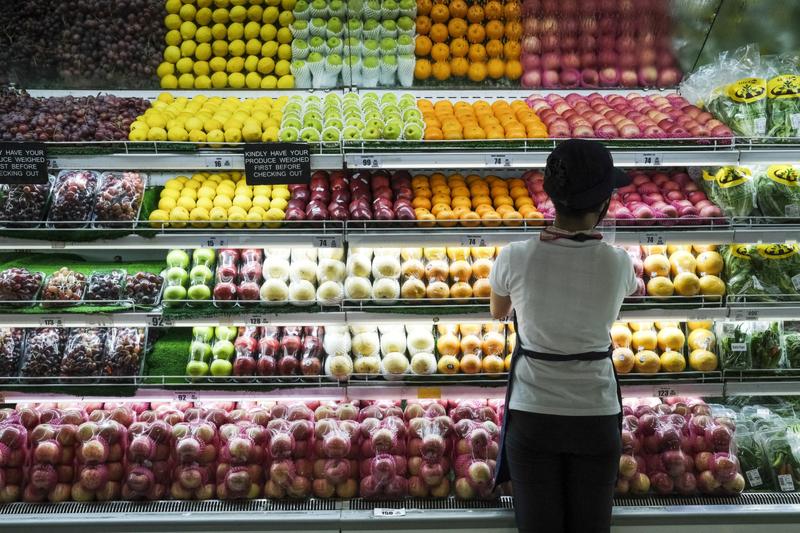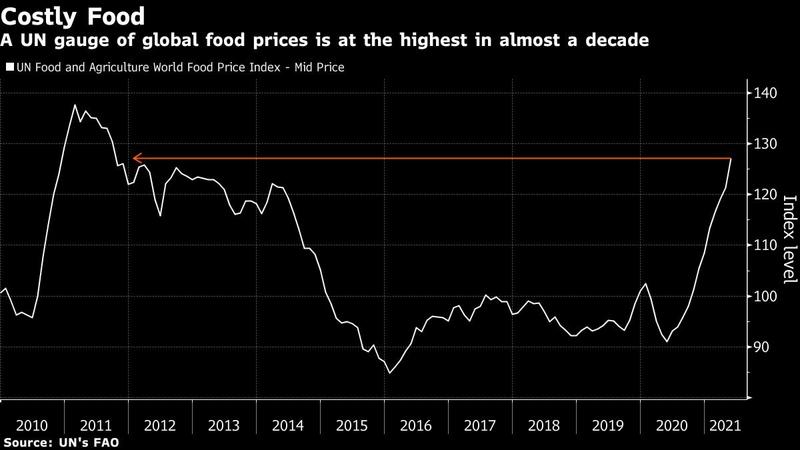 A sales assistant arranges fruit at the fresh produce section in the supermarket at the SM City Bacoor shopping mall in Bacoor, Cavite province, the Philippines, on Thursday, June 3, 2021 (VEEJAY VILLAFRANCA / BLOOMBERG)
A sales assistant arranges fruit at the fresh produce section in the supermarket at the SM City Bacoor shopping mall in Bacoor, Cavite province, the Philippines, on Thursday, June 3, 2021 (VEEJAY VILLAFRANCA / BLOOMBERG)
Consumers may get some respite from surging food prices in the coming years as demand growth slows and output rises, according to the Organisation for Economic Cooperation and Development and UN Food and Agriculture Organization.
A gauge of global food costs has jumped to a nine-year high, squeezing consumer budgets hurt by the COVID-19 crisis. But in the next couple of years, inflation-adjusted prices may ease before staying largely flat through 2030 as demand growth for grains and fish slows and farming supplies rise, the OECD and FAO said in a report.
Greenhouse gas emissions from agriculture were projected to increase by 4 percent over the next 10 years, with livestock accounting for more than 80 percent of the rise
The year-long rally in food prices has raised the cost of everything from pizza dough to meat and coffee. That could push more people into hunger, while threatening faster inflation that may prompt central banks to tighten stimulus measures for economies still in recovery mode after the pandemic.
In the coming decade, agricultural commodities demand is expected to grow 1.2 percent a year, compared with 2.2 percent over the last decade, the OECD and FAO said. Output may rise by 1.4 percent, driven by emerging economies and low-income nations due to investments in infrastructure and research, and more efficient allocations of resources. However, output growth in North America, western Europe and Central Asia will slow amid environmental policy constraints.
In the shorter term, more farm workers will return as countries exit lockdowns and ease travel restrictions, alleviating labor shortages and boosting output, the organizations said.
"The problem is distribution and access to food in some regions," OECD Secretary-General Mathias Cormann said, reiterating his organization's call for farm subsidies to focus more on infrastructure and innovation.
ALSO READ: UN: World food prices surged to highest level since 2011
The 10-year outlook assumes an economic recovery following the coronavirus pandemic in which food markets prove resilient.
Net agricultural exports from Europe and Central Asia are seen doubling over the decade due to Russian and Ukrainian grain shipments.

In contrast, net imports to sub-Saharan Africa are projected to rise by 75 percent by 2030 due to higher imports of wheat, rice, maize and soybean.
According to the report, global per-capita meat consumption will rise 0.3 percent a year over the next decade, with demand in high-income nations leveling off as consumers switch to more expensive cuts.
More people will replace red meat with poultry and dairy products due to health and environmental concerns, with poultry expected to account for 41 percent of meat protein sources by 2030.
Vegetable oil consumption growth may also slow to a third of the previous 10-year pace due to less demand for biofuels in the US and European Union.
On the other hand, Greenhouse gas emissions from agriculture were projected to increase by 4 percent over the next 10 years, with livestock accounting for more than 80 percent of the rise.
READ MORE: IEA: Rebound in global gas demand threatens climate targets
"Thus, additional policy effort will be needed for the agricultural sector to effectively contribute to the global reduction in GHG emissions as set in the Paris Agreement," the FAO and OECD said, adding that productivity gains would cut emissions per unit of output.
With inputs from Reuters


